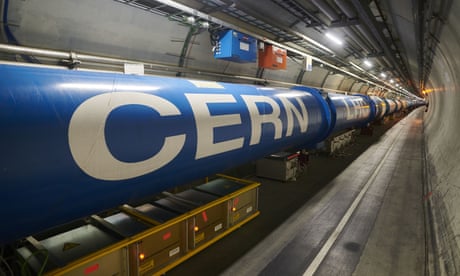It’s 10 years to the day since evidence of the Higgs boson – the elusive particle associated with an invisible mass-giving field – was announced . But for Prof Daniela Bortoletto the memories are as fresh as ever. “I just remember joy.
I remember that everybody was so happy. And what surprised me [was] how everybody was interested, it seemed like the whole world was celebrating us,” she said. Now, as the Large Hadron Collider (LHC) – the monster proton smasher at the European particle laboratory, Cern – gears up to start its third period of data collection on Tuesday, experts are hoping to unpick further secrets of the fundamental building blocks of the universe.
Bortoletto, now head of particle physics at the University of Oxford and part of the team that discovered the Higgs boson , said her main memory of the events a decade ago was the moment two weeks before the announcement when the researchers unblinded their analysis of the data and saw unambiguous signs of the boson. “I still, thinking [about] that moment, get the butterflies in my stomach,” she said. “It was unbelievable.
It’s really a unique moment in the life of the scientist. ” The media furore when the discovery was announced was enormous, with newspapers, radio and TV all focused on a particle as fleeting as it is important. Called the “God particle” and named after physicist Peter Higgs, the Higgs boson is the signature particle of the Higgs field – an invisible energy field that pervades the universe.
In a nutshell, it is the interaction of fundamental particles with this field, interactions first thought to have occurred shortly after the big bang as the universe expanded and cooled, which gives them mass . The existence of the Higgs boson was predicted by the standard model, a key theory that explains three out of the four fundamental forces of nature, but it was not until the seminal experiments at the LHC that scientists found the crucial evidence . Thanks to the discovery of the Higgs boson, scientists can now explain a host of phenomena: from why electrons have mass and hence can create a cloud around a nucleus, giving rise to atoms; to why a neutron is more massive than a proton, and hence why the former decays but the latter is stable.
“The Higgs field explains why atoms exist, why we exist. And the fact that we can put it in a context that we think that we understand, I think is pretty cool,” Bortoletto said. But the story is far from over.
Since the announcement in 2012 there have been further revelations – including insights into how the Higgs boson is born and decays , and its interactions with heavy particles such as top and bottom quarks. And work continues apace. Among other endeavours scientists are hoping to study interactions between the Higgs boson and muons – fundamental, negatively charged subatomic particles – and explore the coupling of the Higgs boson to itself.
“Understanding, for example, the Higgs self-coupling could [help us] understand the shape of the Higgs potential and understand better what happened at the beginning of the universe,” said Bortoletto. Key to such work is the third run of the LHC, due to begin on Tuesday. This time the atom smasher will operate at 13.
6 trillion electronvolts (TeV), up from 13 TeV, with Bortoletto revealing both the Atlas and CMS experiments are expected to double their datasets. “More data and a little bit more energy opens new opportunities,” said Bortoletto. She said scientists would be able to study the Higgs boson in more detail, and the work may also provide new insights into the mass of the W boson.
Another fundamental particle, the W boson was at the heart of a sensation earlier this year when researchers at the Collider Detector at Fermilab in the US revealed their data suggested the particle has a far greater mass than predicted by the standard model. Bortoletto added that there was room for more seminal discoveries. “There is a lot of scope in the Higgs sector,” she said.
“Again, we have a little bit more energy, we might discover something new, some new particle – we have a chance, every time we go higher in energy to discover maybe new physics. ”.
From: theguardian
URL: https://www.theguardian.com/science/2022/jul/04/cern-gears-up-for-more-discoveries-10-years-after-god-particle-find



